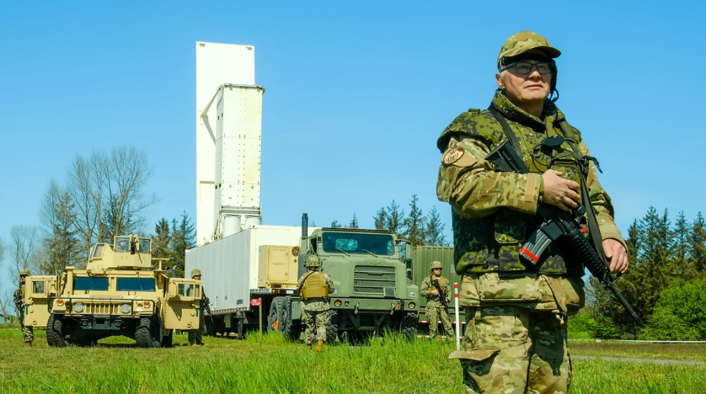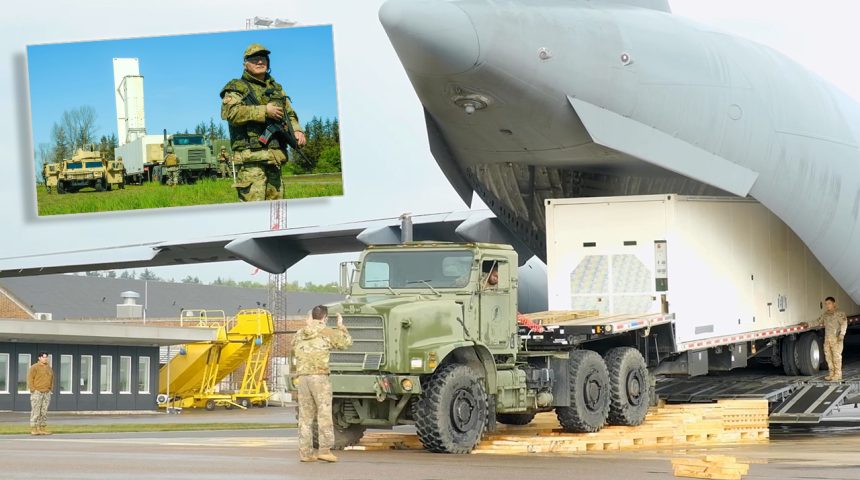The MRC Typhon missile system comprises the SM-6 air defense missile tweaked for anti-shipping roles and Tomahawk subsonic cruise missiles for land targets.
The US Navy has deployed an MRC (Mid-Range Capabilities) Typhon system to the Danish island of Bornholm in the Baltic for an exercise. The sea and surface strike platform, a weapon that had triggered criticism from both Russia and China, introduced around the time of the collapse of the INF (Intermediate-Range Nuclear Forces) Treaty in February 2019, can reach ranges of over 1,500-km.
The first time the system was deployed on the island was in September 2023, marking it the second instance it has been transported there. While the U.S. military’s publicly released material did not formally name the system, calling it a “containerized missile system,” the MK 70 PDS (Payload Delivery System) launcher could be easily identifiable, implying it was the MRC Typhon.

The system was transported to Bornholm Airport in a C-17 Globemaster III of the 3rd Airlift Squadron on May 5, 2024. The statement said the exercise was being held under the Aegis of the “US Naval Forces Europe-Africa/US 6th Fleet.”
The goal is to “conduct the full spectrum of joint and Naval operations, often in concert with Allied and interagency partners, in order to advance US national interests, security and stability in Europe and Africa.” By May 7, US Navy sailors “rehearsed the deployment of (the) containerized missile system,” along with Danish military personnel.
A US Navy MK31 Medium Tactical Vehicle Replacement drives a of containerized launching system off of a US Air Force C-17 Globemaster III at Bornholm Airport in Denmark on May 5. The containerized missile launcher conducts a rehearsal in Bornholm on May 6. pic.twitter.com/WOnmZu69q1
— Ryan Chan 陳家翹 (@ryankakiuchan) May 6, 2024
What is the Typhon System?
The MRC (Mid-Range Capabilities)/Typhon missile system comprises the SM-6 air defense missile tweaked for anti-shipping roles and Tomahawk subsonic cruise missiles for land targets, respectively. The system bridges the range gap between the 482-kilometer range Precision Strike Missile (PrSM) and the 2776-kilometer range of the US Army’s hypersonic Long-Range Hypersonic Weapon (LRHW). In other words, it requires missiles to reach targets up to 1,800-km away.
The INF Treaty had prohibited the signatories – the US and the former Soviet Union – from having ground-launched missiles with ranges of between 500 and 5,500 kilometers. Following its demise in 2019, the US moved fast to re-introduce missiles that cover those ranges.
Earlier in April 2024, the US Army Pacific chief General Charles Flynn announced the deployment of a “long-range precision fire capability (coming) to the region,” without identifying the system. Later that month the US deployed the MRC/Typhon to the Philippines for exercises, drawing China’s ire that accused it of “stoking military confrontation.” In the European theater before Russia, the US had previously deployed the SM-6 variant of the Typhon MRC in September 2023 on Bornholm in the Baltic Sea.
The specific diplomatic and military equations with Russia in the Baltic Sea do not allow the permanent basing of a Typhon in Bornholm, as will be explained subsequently. The system has to be transported back and flown there again for drills. It is also not known if the current Typhon at Bornholm consists of the SM-6 or the Tomahawk versions. However informed guesses can be inferred based on available information and the military-strategic dynamics in the Baltic Sea region.
Typhon vs Russia in the Baltic Sea
For one, Russia has a militarily assertive posture in the Baltic Sea and around its exclave of Kaliningrad, as compared to drills by NATO member nations. These include live drills with Su-27, Su-30SM fighters, and S-400 air-defense systems.
Any permanent fixture of a surface-to-sea system like the Typhon is likely to draw a Russian response with its exercises and lead to escalation – an eventuality both parties wish to avoid.
In fact, the US-NATO exercise with the Typhon on September 18, 2023, was followed by an exercise of Russia’s Baltic Sea Fleet (BSF), where a corvette, the Stoikiy, fired 9M9 Redut missiles on target vessels. This served as a signal that Russia would increase the intensity of its live-fire drills.
Geopolitically, Finland’s accession to NATO also served as a diplomatic statement conveying deterrence to Russia. Moscow would thus interpret a dual military and strategic provocation if Typhons is permanently stationed at Bornholm – a reading that motivated it to attack Ukraine. Therefore, it is likely that the Typhon is shipped to Bornholm only during exercises.
Secondly, given the maritime nature of the theater in the Baltic Sea region, where NATO forces would be facing Russian naval forces as a major component in a clash, the SM-6 variant of the Typhon would be more relevant. This is because the SM-6 has a secondary anti-ship capability.









